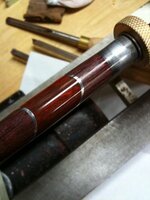Ryan Richardson
Member
I'm still trying to develop a consistent, repeatable CA finish, however, purpleheart continues to give me fits. I think I was able to get the grain filled using the slurry method which was my first problem. Now, it looks like the CA finish isn't sticking to the purpleheart. Looking at the picture, you can see where there is a gloss over the redheart and aluminum, but then gets dull over the purpleheart. Reminds me of the first time I tried to put a finish on cocobolo.
The blank is sanded to 600 grit, micromeshed to 3200 then EEE. The finish is being applied by taking a folded up strip of paper towel, putting a drop of BLO on then applying that to the blank, then taking a drop of thick CA and applying that to the blank, folding the towel over and rubbing back and forth to smooth it out; similar to that youtube video. After the last coat of CA, I polished the blank with some PSI One Step plastic polish.
Any thoughts or suggestions? Thanks in advance.
The blank is sanded to 600 grit, micromeshed to 3200 then EEE. The finish is being applied by taking a folded up strip of paper towel, putting a drop of BLO on then applying that to the blank, then taking a drop of thick CA and applying that to the blank, folding the towel over and rubbing back and forth to smooth it out; similar to that youtube video. After the last coat of CA, I polished the blank with some PSI One Step plastic polish.
Any thoughts or suggestions? Thanks in advance.

